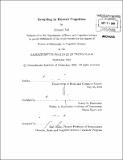| dc.contributor.advisor | Nancy G. Kanwisher. | en_US |
| dc.contributor.author | Vul, Edward | en_US |
| dc.contributor.other | Massachusetts Institute of Technology. Dept. of Brain and Cognitive Sciences. | en_US |
| dc.date.accessioned | 2011-04-04T17:40:06Z | |
| dc.date.available | 2011-04-04T17:40:06Z | |
| dc.date.copyright | 2010 | en_US |
| dc.date.issued | 2010 | en_US |
| dc.identifier.uri | http://hdl.handle.net/1721.1/62097 | |
| dc.description | Thesis (Ph. D.)--Massachusetts Institute of Technology, Dept. of Brain and Cognitive Sciences, 2010. | en_US |
| dc.description | Cataloged from PDF version of thesis. | en_US |
| dc.description | Includes bibliographical references (p. 117-126). | en_US |
| dc.description.abstract | Bayesian Decision Theory describes optimal methods for combining sparse, noisy data with prior knowledge to build models of an uncertain world and to use those models to plan actions and make novel decisions. Bayesian computational models correctly predict aspects of human behavior in cognitive domains ranging from perception to motor control and language. However the predictive success of Bayesian models of cognition has highlighted long-standing challenges in bridging the computational and process levels of cognition. First, the computations required for exact Bayesian inference are incommensurate with the limited resources available to cognition (e.g., computational speed; and memory). Second, Bayesian models describe computations but not the processes that carry out these computations and fail to accurately predict human behavior under conditions of cognitive load or deficits. I suggest a resolution to both challenges: The mind approximates Bayesian inference by sampling. Experiments across a wide range of cognition demonstrate Monte-Carlo-like behavior by human observers; moreover, models of cognition based on specific Monte Carlo algorithms can describe previously elusive cognitive phenomena such as perceptual bistability and probability matching. When sampling algorithms are treated as process models of human cognition, the computational and process levels can be modeled jointly to shed light on new and old cognitive phenomena.. | en_US |
| dc.description.statementofresponsibility | by Edward Vul. | en_US |
| dc.format.extent | 126 p. | en_US |
| dc.language.iso | eng | en_US |
| dc.publisher | Massachusetts Institute of Technology | en_US |
| dc.rights | M.I.T. theses are protected by
copyright. They may be viewed from this source for any purpose, but
reproduction or distribution in any format is prohibited without written
permission. See provided URL for inquiries about permission. | en_US |
| dc.rights.uri | http://dspace.mit.edu/handle/1721.1/7582 | en_US |
| dc.subject | Brain and Cognitive Sciences. | en_US |
| dc.title | Sampling in human cognition | en_US |
| dc.type | Thesis | en_US |
| dc.description.degree | Ph.D. | en_US |
| dc.contributor.department | Massachusetts Institute of Technology. Department of Brain and Cognitive Sciences | |
| dc.identifier.oclc | 707633257 | en_US |
